Model-Free Predictive Control for a Kind of High Order Nonlinear Systems
2022-05-20YeTianandBailiSu
Ye Tian and Baili Su
(School of Engineering College, Qufu Normal University, Rizhao 276826, Shandong, China)
Abstract: For a type of high-order discrete-time nonlinear systems (HDNS) whose system models are undefined, a model-free predictive control (MFPC) algorithm is proposed in this paper. At first, an estimation model is given by the improved projection algorithm to approach the controlled nonlinear system. Then, on the basis of the estimation model, a predictive controller is designed by solving the finite time domain rolling optimization quadratic function, and the controller’s explicit analytic solution is also obtained. Furthermore, the closed-loop system’s stability can be ensured. Finally, the results of simulation reveal that the presented control strategy has a faster convergence speed as well as more stable dynamic property compared with the model-free sliding mode control (MFSC).
Keywords: nonlinear system; compact dynamic linearization (CDL); model predictive control (MPC); model-free control (MFC); projection algorithm
0 Introduction
Thecontrollerdesignisusuallyfoundedonthemathematicalmodelwiththecontrolledprocesspreciselygiveninmoderncontroltheory.However,themodel-basedcontrolalgorithmsoftencannotachievetheexpectedeffectintheactualproductionapplicationduetotheunmodeleddynamicsanduncertainvariousfactorsinthemodelingprocess.Inthewakeoftheprogressofscienceandtechnology,becauseoftheincreasingscaleofindustrialproductionandtheincreasingcomplexityofthenonlinearsystemintheactualproductionprocess,wecannotgetaprecisesystemmodelinrelationtothecontrolledprocess.Therefore,weconsiderdesigningcontrolmethodswhicharenotbasedonprecisemathematicalmodels.
MFCmethodisakindofdata-drivencontrol(DDC)methods.Itonlyusesthecurrentandpastinput/outputdata(IOD)ofthecontrolledprocesstopredictfuturedynamics.ThemainMFCmethodsintheearlystudiesarebasedonthespeciallinearsystemstructureandthegradientestimationmethodbasedontheIODofthecontrolledsystemforgeneralnonlinearsystems.Just-in-timemodelingisakeystepindata-drivencontrol.Just-in-timemodeling,alsocalledtheinstance-basedlearning[1],on-demandmodel[2],ordelaylearning[3],isfirstproposedinRef.[4].Therefore,asaneffectivecontrolmethod,scholarshavecarriedoutextensiveresearchonMFCmethodinrecentyears.Ref.[5]putsforwardamodel-freeadaptivecontrolmethod(MFAC)inlinewiththeCDLtechnologyregardingakindofHDNS.ThedesignofthecontrolleronlyutilizestheIODofthecontrolledobjecttoensurecontrolperformanceandtheconvergencetowardstrackingerrors.Inallusiontoakindofordinarydiscrete-timenonlinearsystemswhicharemulti-inputandmulti-outputsystems(MIMO),Ref.[6]proposesadata-drivenMFACalgorithmbasedonpseudo-partialderivatives,andtheCDLandpartialdynamiclinearization(PDL)arediscussedrespectively.Ref.[7]changesthenonlineartime-varyingtrafficnetworkdescriptionintothesimplifieddatamodel,sothatthemodel-freemodelhasbeensuccessfullyappliedinpractice.
MPCisafinitetimeoptimizationcontrolmethodgeneratedfromindustrialprocess.MPCincludesthreefundamentalcharacteristicswhicharemodelprediction,rollingoptimization,andfeedbackcorrection.Itisacontrolstrategythatusesthesystemdynamicmodeltopredictthefuturesystemresponse.BecauseMPChastheadvantagesoflowrequirementonmodel,easyon-linecalculation,andoptimizationdesign,inrecentyearsmanyscholarshavecombinedMPCwithmodel-freemethodtoproduceabatchofhigh-qualitycontrolmethods.Atthebeginningofthe21stcentury,somescholarscombinedMFACwithMPCandputforwardthemodel-freeadaptivepredictivecontrolmethod[8].However,thismethodrequiresthepredictionofthepan-modelfeaturevectorsatfuturemoments,andthecontroleffectisnotidealduetotheimpreciseprediction.Therefore,inrecentyears,ithasbecomeahottopicforsomeresearcherstousethelinearmodeldescribedbypseudopartialderivativematrix(PPDM)tocharacterizetheHDNS,andithasbeenappliedinvariousdomains,forexample,food,chemical,industry,aviation,andsoon.Ref.[9]presentsanMFACmethodforakindofnonlinearsystemswhicharedepictedbynonlinearautoregressivemovingaveragemodelbasedonRefs.[5]and[6].Ref.[10]studiestherelationshipbetweenMFPCandMPCwhichisgroundedonparameterestimation.Thenoisepollutionconditionisaddedintothehypothesis,andtheobtaineddataareoptimizedtoobtainmoreaccuratedata.Ref.[11]introducesanMFPCmethodfornonlinearsystemsbasedonpolynomialregressionexpression.TheMFPCmethodbasedonthelinearregressionvectorofIODisextendedtothepolynomialregressionvector.Ref.[11]isgeneralizedtoMIMOsystemsinRef.[12]whichrealizesitsapplicationinwastewatertreatment.Ref.[13]proposesamodel-freepredictivehybridsensitivity(PHS)H∞controlmethodbasedontheIODtoobtaintheoptimalPHSperformancebyusingthemaximumminimizationmethod.Furthermore,itappliesthecontrolstrategytothesolarpowergridsystem.However,theseMFPCalgorithmsoftenrequirealargeamountofcomputationandneedtosolvecomplexnonlinearprogrammingproblemsonline,soitisnotfaciletoacquiretheexplicitanalyticsolutions.InallusiontoakindofHDNSwhichhaveunknowndynamics,anMFSCapproachbasedonthesystem'sIODandtheconstructionofanadaptiveobservertodeterminethePPDMisproposedinRef.[14].Butthismethodhassomelimitationsinsystemselectionandhashigh-frequencytremor,sothecontrolofsomecomplexindustrialprocesseswillbecomedifficultandunsatisfactory.
ThispaperproposesanMFPCmethodforakindofHDNSwhichareapproachedbyanestimationsystem.Comparedwithothernonlinearcontrolalgorithms,itnotonlyrequireslesscomputation,butalsosolvestheoptimizationproblem,andstablestheclosedloopsystem.Theremainderofthearticleisdescribedbrieflyasfollows:inSection1,theCDLtechniqueisusedtoestablishadata-drivenmodelregardingHDNS.InSection2,anestimationsystemisdesignedandtheestimationofthePPDMisgiven.InSection3,thepredictionmodelisestablished,andtheappropriatecontrollawisobtainedafterrollingoptimization.Then,therationalityandeffectivenessofthemethodareverifiedviathesimulationresultsfromSection4.Intheend,thesumming-upisarrangedinSection5.
1 Question Description
ConsidertheHDNSbelow,whichhasanextendedexternalinput:
(1)
wherexi∈R(i=1,2,…,n),y∈R,andu∈Rarestatevariables,output,andinputofthesystem,respectively.txi,jandtudenotesystemorders.Thefunctionsfi(·)(i=1,2,…,n)representtheunidentifiedsmoothfunctions.
CDLmethodintroducestheconceptofPPDMandpseudo-order,andonlyconsidersthedynamicrelationshipbetweenthenextmoment’soutputvariationandthecurrentmoment’sinputvariation.CDLtechnologycanbeusedtotransformtheHDNSintoalineartime-varyingdynamicdatamodelwithscalarparameters.InordertoadopttheCDLapproach,wemakethefollowingassumption.
Assumption 1Partialderivativeregardingfi(·) (i=1,2,…,n-1)inrelationtox1(t), …,xi-1(t),xi+1(t),andpartialderivativeregardingfn(·)inrelationtox1(t),…,xn-1(t),u(t)keepcontinuous.Justforthesakeofpresentation,leti=1,2,…,n,ifi=n,then,xn+1(t)=u(t).
Theorem 1Groundedontheaboveassumption,system(1)canberepresentedasthefollowingform:
ΔX(t+1)=Η(t)Λ(t)
(2)
where
ΔX(t+1)=[Δx1(t+1),…,Δxn(t+1)]T
Λ(t)=[Δx1(t),…,Δxn(t),Δu(t)]T
Δxi(t+1)=xi(t+1)-xi(t)
Δu(t)=u(t)-u(t-1)
whereH(t)∈Rn×(n+1)standsforPPDM,γijrepresentsγij(t).
ProofLet
xl-1(t-txl-1,i),xl(t-1),xl(t-1),…,
xl(t-txli),…,xi+1(t),…,xi+1(t-
txi+1,i))(l=1,…,i-1,i+1)
Fromsystem(1),theequationisrepresentedasfollows:
Δxi(t+1)=ϑi+ξi
(3)
where

(4)
(5)
AccordingtotheLagrangemeanvaluetheorem,hereupon
(6)

Similarly,ξiisredescribedasfollows:
(7)
where
gib(x(t))=gib(x1(t-1),…,x1(t-tx1i-1),…,xb-1(t-txb-1,i-1),xb(t),xb(t-1),…,xb(t-
txbi-1),…,xi+1(t),…,xi+1(t-txi+1,i-1))

Inallusiontoeveryfixedt,thefollowingequationwhichinvolvethevectorωi(t)isconsidered.
gi,i+1=ωi(t)ΔΨ(t)
(8)

ξi=βi1(t)Δx1(t)+…+βi,i-1(t)Δxi-1(t)+
βi,i+1(t)Δxi+1(t)
(9)
where
(10)
FromEq.(9),thefollowingequationcanbeobtained:
IncombinationwithEqs.(6)and(9),Δxi(t+1)isrewrittenasfollows:
Δxi(t+1)=γi1Δx1(t)+…+γi,i-1Δxi-1(t)+
γi,i+1Δxi+1(t)
(11)
where
(12)
FromEq.(11),Eq.(1)canberepresentedinanotherformasEq.(2).
2 PPDM Estimation
Thetime-varyingparametersoftheunknownPPDMareestimatedusinganapproximationinthissection.Manyalgorithmscanbechosen,forexample,theleakagerecursiveleastsquaresalgorithm,theimprovedprojectionalgorithm,ortheleastsquaresalgorithmwhichhastime-varyingforgettingfactor.Here,animprovedprojectionalgorithmisusedtoestimatePPDM.
DividingH(t),Λ(t)intoblocks,then
X(t+1)=X(t)+Η1(t)Λ1(t)+Η2(t)Δu(t)
(13)
whereX(t),X(t+1)∈Rn,H(t)∈Rn×(n+1),H1(t)∈Rn×n,H2(t)∈Rn,Λ1(t)∈Rn,andΛ(t)∈Rn+1.
Anestimationsystemisdesignedasfollows:
(14)

Let
f(x,u,Η1)=Η1(t)Λ1(t)+Η2(t)Δu(t)
(15)
ReferringtoRef.[15],theimprovedprojectionalgorithmisusedtoestimatePPDM.Thepseudopartialderivativeestimationcriteriaisselectedasfollows:

(16)


(17)
Similarly,
(18)
wheretheconstantμ1,μ2>0aretheweightfactor.


(19)
Remark 1:InEq.(16),asquaretermwithaweightingfactorofμ1isintroducedtopenalizelargeparametererrors,whichmakestheestimationalgorithmrobustwhenthereareindividualabnormaldata.ItcanbeseenfromEqs.(17)and(18)thattheintroductionofμ1,μ2canavoidtheoccurrenceofzerodenominator.
Remark 2:Thefactorsθ1andθ2areaddedtoEqs.(17)and(18)toenhancethegeneralityofthealgorithm.
3 MPC
3.1 MPC
Inthispart,theestimationsystem(14)isutilizedasapredictionmodeltodesignapredictioncontroller.
AccordingtoEq.(13),thesystemmodelcanbeexpressedasfollows:
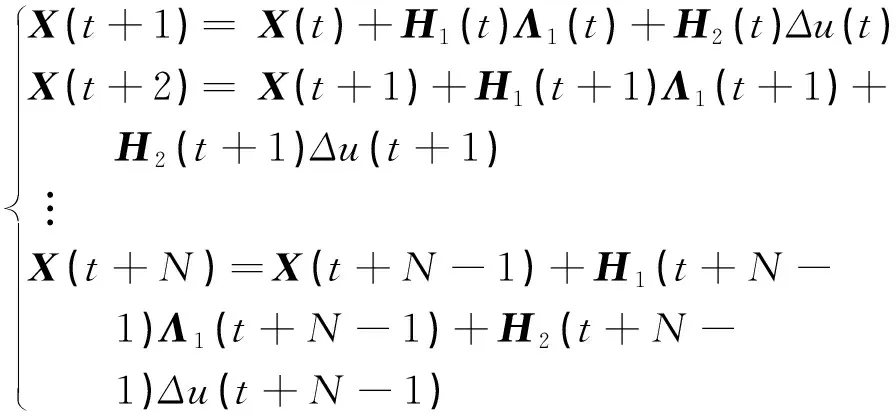
(20)
UnfoldingX(t+s)(s=1,2,…,N-1),whichareontherightsideofEq.(20),Eq.(20)canberewrittenasfollows:
XM(t)=PX(t)+Η1M(t)Λ1M(t)+Η2M(t)ΔU(t)
(21)
where
XM(t)=[XT(t+1),XT(t+2),…,XT(t+N)]T
P=[I,I,…,I]T
ΔU(t)=[Δu(t),Δu(t+1),…,Δu(t+N-1)]T
whereI∈Rn×nistheidentitymatrix,H1M(t)∈RnN×nN,H2M(t)∈RnN×N,P∈RnN×n,ΔU(t)∈RN,Λ1M(t)∈RnN,andXM(t)∈RnN.
Attimet,giventhepredictionofthestatesabouttheestimationsystem(14).Similarly,itcanbeinterpretedasfollows:
(22)
where
FromEqs.(21)and(22),thefollowingequationcanbededuced:
(23)
whereEM(t)=[ET(t+1),ET(t+2),…,ET(t+N)]Thequadraticfunctionofrollingoptimizationinfinitetimedomainisusedastheperformanceindex:
(24)

ReferringtoRef.[16],substituteEq.(23)toEq.(24).Thereis
(25)


(26)
Let
u(t)=u(t-1)+ΞΔU(t)
(27)
whereΞ=[1,0,…,0],Ξ∈R1×N.Thesystemcanbestabilizedbyusingthecontroller(27).
3.2 Steps
Basedontheaboveanalyses,thebasicstepsoftheMFPCalgorithmproposedinthispaperareasfollows:



Step 4:Applyu(t)tosystem(13)toobtainthesystemstatesatthetimeoft+1.
Step 5:Lett=t+1andkeepuptoStep1.
4 Simulation
Inthispart,threesimulationexamplesareusedtoprovetheabovealgorithm.
Example 1:
Thetunneldiodeisacrystaldiodewhosemaincurrentcomponentisthetunneleffectcurrent.Ithassuchcharacteristicsashighspeedandhighrunningfrequency.Hence,thetunneldiodeiswidelyusedinsomeswitchingcircuitsandhighfrequencyoscillationcircuits.Inthispart,thenonlinearmodeloftunneldiodecircuitistakenasaninstancetoprovethefeasibilityoftheMFPCalgorithm.
ConsideringthetunneldiodecircuitwhichisdescribedinFig1,whereL,C,R,andDrepresentinductance,capacitance,resistance,andthetunneldiode,respectively,iandvarethecurrentandvoltagepassingthroughthecorrespondingcomponent.ThecharacteristicofthiscircuitisiD=h(vD).Definex1=vC,x2=iL,E=u.Inthiscase,L=5,C=2,R=1.5,andh(x1)=17x1-103x12+229x13areselected.AccordingtoKirchhoff'slawofcurrentandvoltage,thecontrolsystemisdescribedasfollows:

Fig. 1 Tunnel diode circuit


Fig.2 State x1
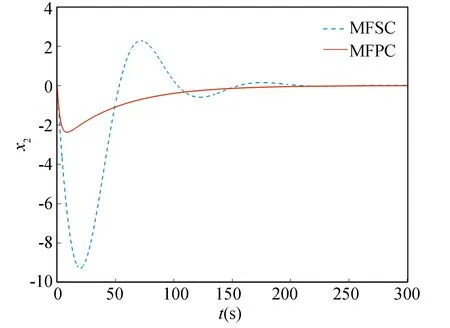
Fig.3 State x2

Fig.4 Input u
Fromthesimulationresultsofthetunneldiodecircuit,itcancometotheconclusionsthattheMFPCalgorithmproposedinthisarticlecanwarrantthatthesystemstatesarefinallystableforthediscretenonlinearsystemwithunknownsystemmodel.TheovershootoftheMFPCalgorithmissmallerandthesystemconvergesfasterincomparisonwiththeMFSCalgorithm.
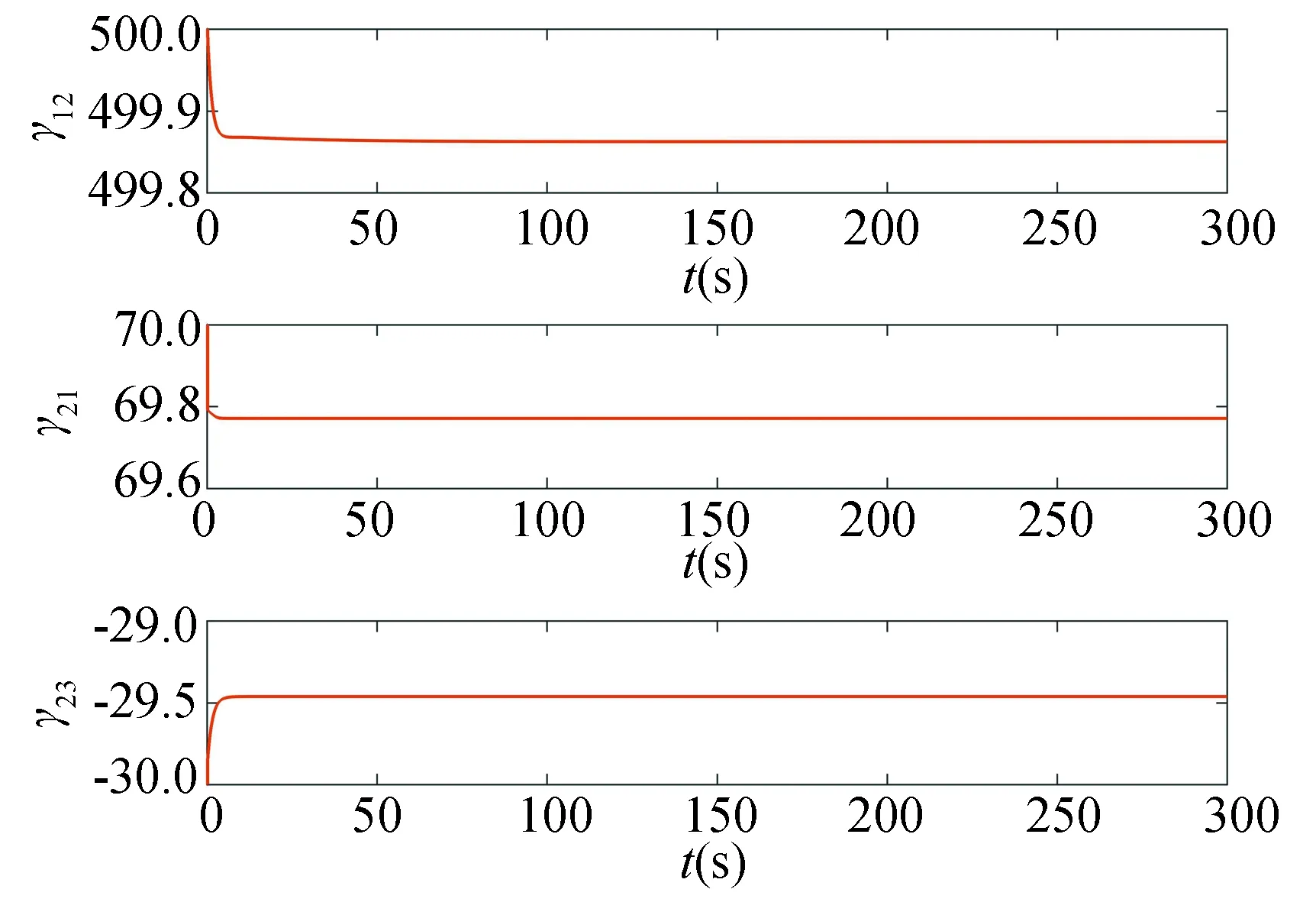

Example 2:
ThestirredtanksystemunderastandardmodelingassumptionistakenasaninstancetoprovethefeasibilityoftheMFPCalgorithm.Thecontrolsystemisdescribedasfollows:


Fig.6 State x1
Fromtheabovesimulationresults,itcanbeseenthatbothcontrollerscanwarrantthatthesystemstatesarefinallystableforthediscretenonlinearsystemwithunknownsystemmodel.However,theMFPCcanreachstabilityataboutt=100s,whiletheMFSCcanbestableataboutt=200s.Moreover,comparedwiththeMFSC,theMFPChaslessovershoot.

Fig.7 State x2
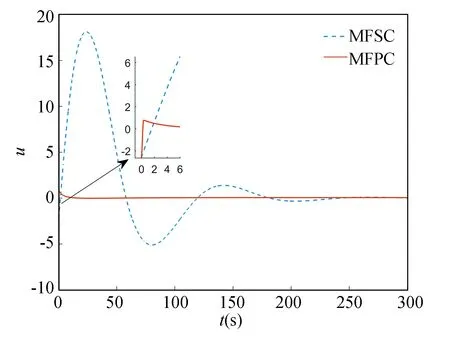
Fig. 8 Input u


Example 3 (Robust problem):
ForthesysteminExample1,anonlinearperturbationtermisaddedtothesystemmodel:
Assumingthatthediscretetime,initialvalue,andparametersremainunchangedasinExample1.ThesimulationconsequencesonthebasisoftheabovearegiveninFigs.10-12.
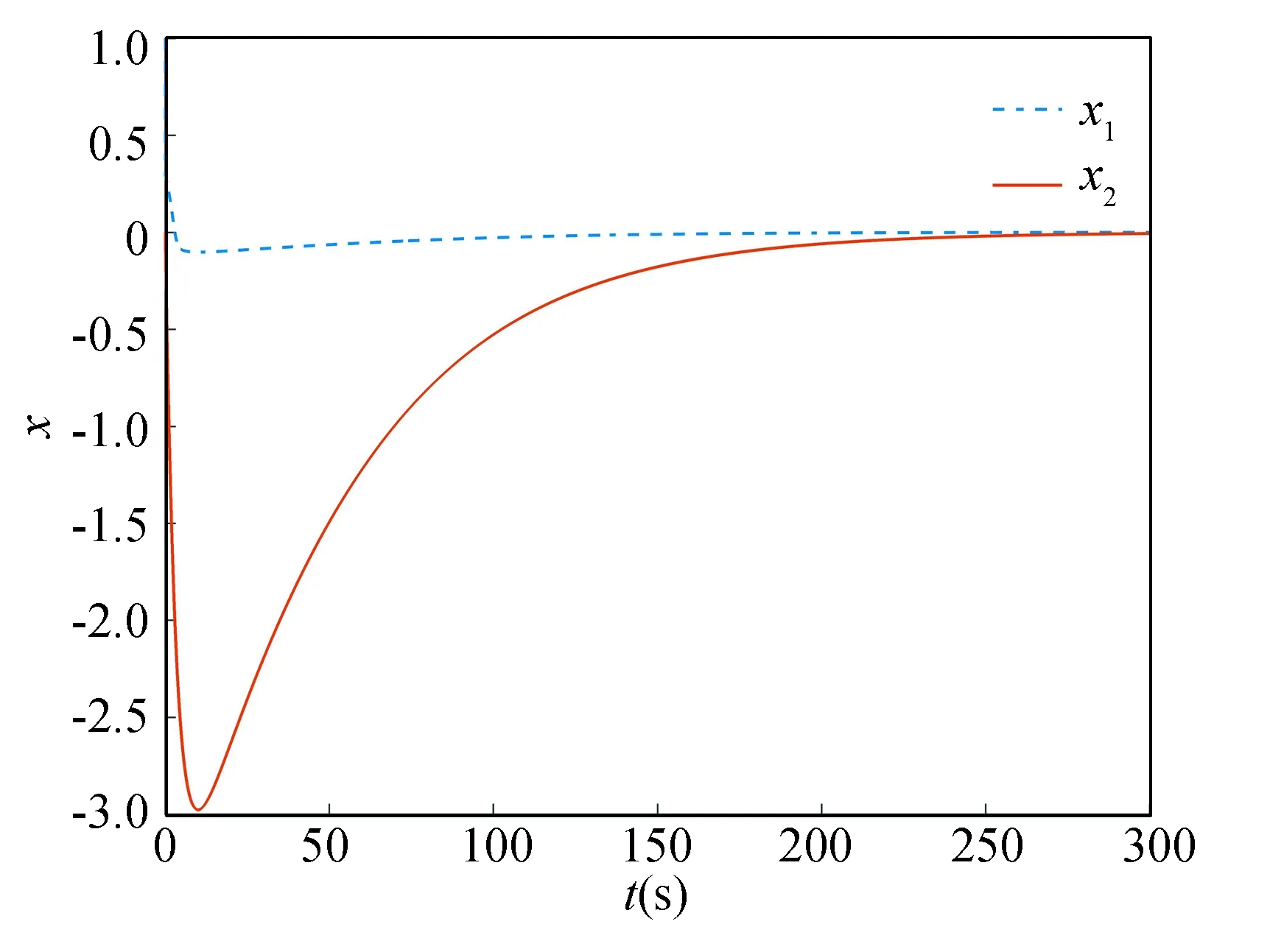
Fig.10 State x
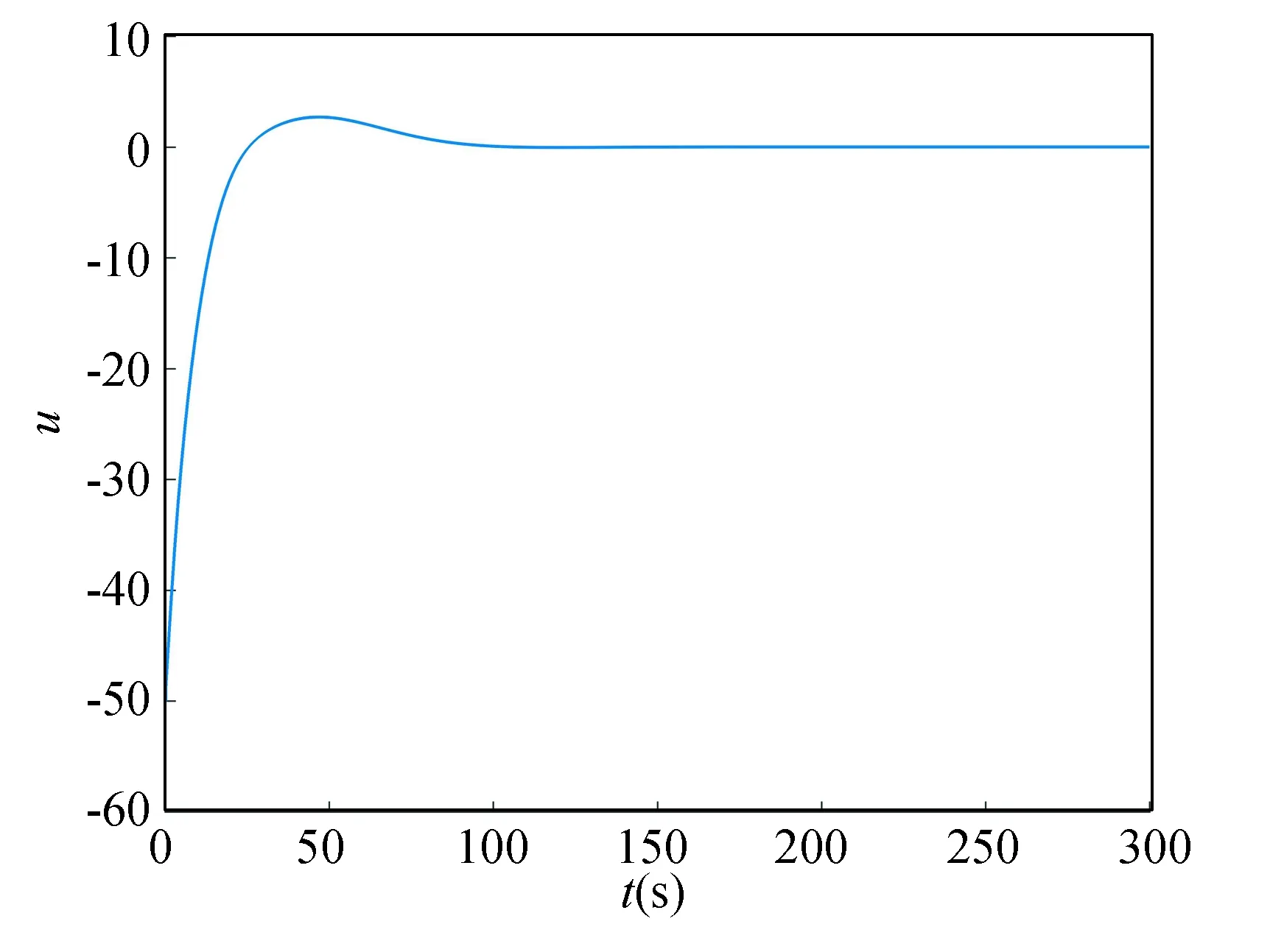
Fig.11 Input u


Itisclearfromtheabovesimulationfindings,theMFPCsuggestedinthischaptercanstillmakethesystemstableafteraddingthenonlineardisturbancetermintothesystem.Therefore,theMFPChasgoodrobustness.
5 Conclusions
Inthisarticle,anMFPCmethodisdevisedforakindofHDNSwhosesystemmodelsareundefined.Thesystemexpressedbypseudo-partialderivativematrixisobtainedbycompactformdynamiclinearizationmethod.Theimprovedprojectionalgorithmisusedtodesignanestimationsystemtoapproximatethecontrolledsystem.Anappropriatepredictivecontrollerisdesignedandtheexplicitanalyticalsolutionofthecontrolisobtained,whichfinallymakesthesystemstable.TheMFPCapproachhasexcellentrobustnessandstabilityaccordingtothesimulationconsequences.ComparedwiththeMFSCmethod,theMFPCmethodproposedinthispaperhassmallerovershootandfastersystemconvergence.Futureworksgroundedonthisarticleshouldcomprise:
1)expandingtheproposedMFPCtoMIMOnonlinearsystems;
2)thecontrolproblemsofotherspecialtypesofnonlinearsystemssuchasfractionalordersystemswithtimedelay.
杂志排行
Journal of Harbin Institute of Technology(New Series)的其它文章
- Optimal Kinematics Design of MacPherson Suspension: Integrated Use of Grey Relational Analysis and Improved Entropy Weight Method
- Power Control Based on State Space Strategies for Grid-Oriented Inverters with LCL Filters
- Research on Sound Absorption Method of Perforated Tube with Shunt Hedge
- Optimal Motion Planning of the Space Manipulator for Minimum Reaction Torque to Satellite
- Investigation on Liquid Breakup Regimes and Atomization Performance of Slinger
- Characteristics of Convection Heat Transfer in Power-Law Fluid Saturated Porous Media Channel
